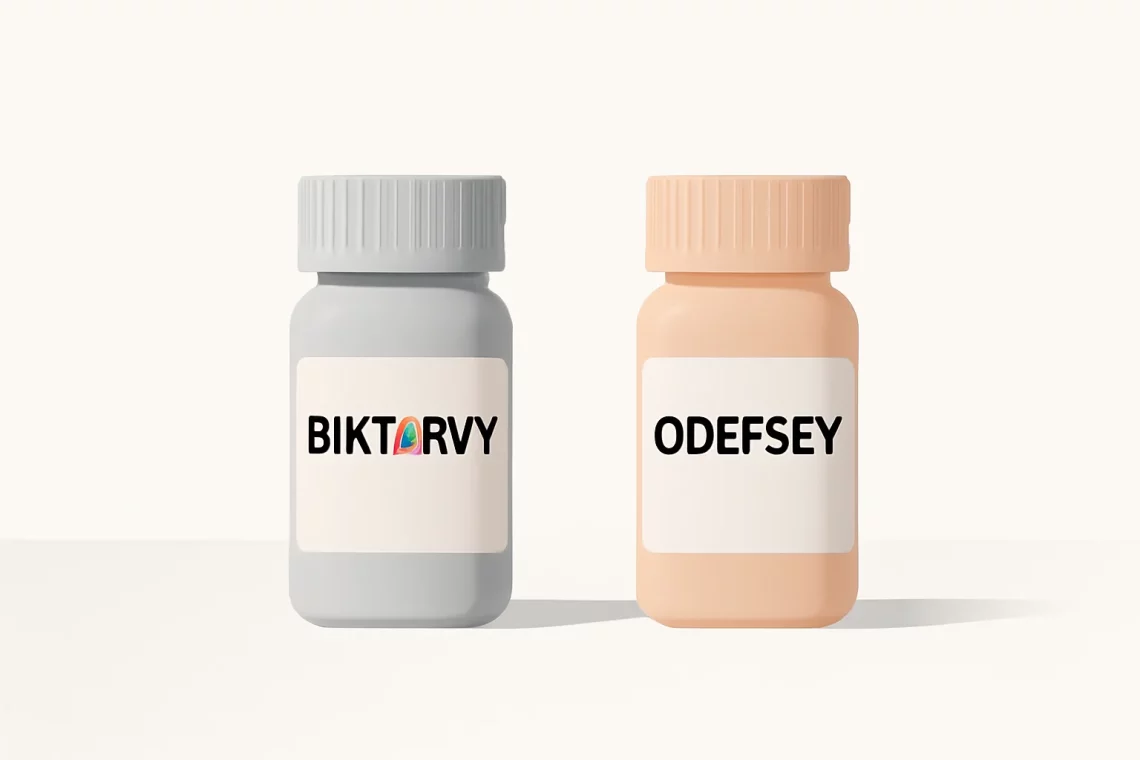
Biktarvy vs Odefsey: A Comprehensive Comparison of HIV Treatments
In recent years, the landscape of HIV treatment has evolved significantly, offering patients a range of options tailored to their specific needs. With the rise of antiretroviral therapy, medications like Biktarvy and Odefsey have gained prominence for their effectiveness and convenience. As individuals living with HIV navigate their treatment journey, understanding the differences between these two regimens becomes crucial for making informed decisions.
Both Biktarvy and Odefsey represent advanced formulations aimed at simplifying the treatment process, reducing pill burden, and improving adherence. These medications combine different classes of antiretroviral drugs to achieve viral suppression while minimizing side effects. As a result, patients are often left wondering which option might be more suitable for their particular circumstances.
In this discussion, we will delve into the composition, efficacy, side effects, and other key factors that differentiate Biktarvy from Odefsey. By examining these elements, we aim to provide a comprehensive overview that can assist individuals in making educated choices regarding their HIV treatment options.
Understanding Biktarvy
Biktarvy is a combination medication that consists of three active ingredients: bictegravir, emtricitabine, and tenofovir alafenamide. This three-drug formulation is designed to provide a potent and effective means of HIV treatment by targeting the virus at multiple points in its lifecycle. Bictegravir is an integrase strand transfer inhibitor, which works by blocking the virus from integrating its genetic material into the host’s DNA. This helps prevent the replication of the virus and contributes to lower viral loads.
One of the key advantages of Biktarvy is its once-daily dosing regimen, which simplifies adherence for patients. This single-tablet regimen not only reduces the number of pills a patient has to take but also helps improve adherence to treatment, which is critical for maintaining viral suppression. Furthermore, Biktarvy has been found to have a high barrier to resistance, making it a reliable choice for both treatment-naïve patients and those switching from other regimens.
Clinical studies have shown that Biktarvy effectively suppresses viral loads to undetectable levels in a significant percentage of patients. In addition to its efficacy, Biktarvy has a favorable safety profile, with most side effects being mild and manageable. Common side effects reported include headache, fatigue, and gastrointestinal issues, but serious adverse effects are rare.
Another notable aspect of Biktarvy is its potential for kidney and bone health. The formulation of tenofovir alafenamide is less nephrotoxic compared to older formulations, making it a safer option for patients who may have concerns about kidney function. This is particularly important given the long-term nature of HIV treatment.
In summary, Biktarvy stands out as a robust option for HIV treatment, offering a combination of efficacy, convenience, and a favorable safety profile. For many patients, its once-daily dosing and low risk of resistance make it an appealing choice in the landscape of antiretroviral therapies.
Exploring Odefsey
Odefsey is another combination medication that consists of rilpivirine, emtricitabine, and tenofovir alafenamide. Similar to Biktarvy, Odefsey is designed as a single-tablet regimen, providing the convenience of once-daily dosing. This medication is particularly notable for its use of rilpivirine, a non-nucleoside reverse transcriptase inhibitor (NNRTI), which works by blocking the reverse transcriptase enzyme that HIV needs to replicate.
One of the primary advantages of Odefsey is its efficacy, particularly in patients with a baseline viral load that is not excessively high. Clinical trials have demonstrated that Odefsey can achieve viral suppression in many individuals, making it a viable option for treatment-naïve patients. However, it’s important to note that Odefsey is generally recommended for patients with a viral load below a certain threshold, which distinguishes it from Biktarvy in terms of eligibility criteria.
Side effects associated with Odefsey can include insomnia, headache, and gastrointestinal disturbances. While most side effects are mild, there is a potential risk of more serious effects, particularly related to mood changes or depressive symptoms, due to the rilpivirine component. Patients considering Odefsey should be aware of these potential side effects and discuss them with their healthcare provider.
In terms of drug interactions, Odefsey has specific considerations due to its rilpivirine content. Certain medications can impact the effectiveness of Odefsey, making it essential for healthcare providers to evaluate a patient’s complete medication regimen before prescribing this treatment. This aspect is particularly important for individuals who may be taking other medications for coexisting health conditions.
Odefsey also has a favorable safety profile regarding kidney function, similar to Biktarvy. The tenofovir alafenamide component is known for its lower risk of renal toxicity compared to older tenofovir formulations, making Odefsey a safer option for long-term use.
In conclusion, Odefsey presents a solid option for HIV treatment, particularly for patients who meet its specific criteria. Its once-daily dosing and effective viral suppression make it an attractive choice, but careful consideration of side effects and drug interactions is crucial for optimal management.
Comparing Efficacy and Side Effects
When comparing Biktarvy and Odefsey, one of the most important aspects to consider is their efficacy in achieving and maintaining viral suppression. Both medications have been shown to be highly effective, but there are nuances that can influence a patient’s choice.
Biktarvy has demonstrated higher efficacy in clinical trials among individuals with a wider range of baseline viral loads. This makes it suitable for a broader population, including treatment-naïve patients and those who may have previously failed other therapies. The integrase inhibitor bictegravir provides a robust mechanism against viral replication, contributing to its effectiveness.
On the other hand, Odefsey has shown effectiveness primarily in patients with lower baseline viral loads. While it can achieve viral suppression, its efficacy may be compromised if a patient’s viral load exceeds a specific threshold. This distinction is crucial for healthcare providers when determining the most appropriate regimen for their patients.
In terms of side effects, both medications have relatively mild profiles, but there are some differences worth noting. Biktarvy’s side effects are generally mild, with headache and gastrointestinal issues being the most common. Serious side effects are rare, making it a well-tolerated option for many patients.
Conversely, Odefsey carries a slightly higher risk of mood-related side effects due to the rilpivirine component. While these occur infrequently, they can be significant for some individuals, particularly those with a history of mental health issues. Patients should be aware of these potential side effects and communicate openly with their healthcare providers about any concerns.
Both medications also offer favorable renal safety profiles, but the specific risks and benefits may vary based on individual patient factors. For patients with existing kidney concerns, Biktarvy’s formulation may be particularly appealing due to its low nephrotoxicity.
Ultimately, the choice between Biktarvy and Odefsey should be made collaboratively between patients and their healthcare providers. Factors such as baseline viral load, potential side effects, and personal preferences all play a critical role in determining the most suitable treatment plan.
Patient Considerations and Lifestyle Impacts
When deciding between Biktarvy and Odefsey, it’s essential to consider how each medication aligns with a patient’s lifestyle and individual needs. Both medications provide the convenience of once-daily dosing, which can significantly enhance adherence and overall treatment success. However, lifestyle factors, potential side effects, and personal preferences can influence the decision-making process.
For patients who prioritize ease of use and a simplified regimen, both Biktarvy and Odefsey offer single-tablet solutions that are easy to incorporate into daily routines. This convenience can be particularly beneficial for those who may have busy schedules or who struggle with medication adherence. A single daily pill reduces the complexity of managing multiple medications, which can lead to better outcomes in the long term.
However, lifestyle factors extend beyond just the frequency of dosing. For example, patients who travel frequently or have unpredictable routines may find the flexibility of a once-daily regimen advantageous. Both medications can be taken with or without food, adding to their convenience for patients on the go.
Furthermore, patients should consider the potential side effects of each medication in relation to their daily lives. For individuals with concerns about mood changes, Odefsey’s rilpivirine component may be a significant consideration. Patients who have experienced depression or anxiety in the past may prefer to opt for Biktarvy, which generally has a more favorable side effect profile in this regard.
Additionally, the potential for drug interactions is a critical consideration for many patients, particularly those managing other health conditions. A thorough discussion with a healthcare provider about existing medications and any potential interactions with Biktarvy or Odefsey is essential for ensuring safety and efficacy.
Lastly, patient education and support play a significant role in the treatment process. Engaging with healthcare providers, support groups, or educational resources can empower patients to make informed decisions about their treatment options. Understanding the nuances of each medication can help individuals feel more confident in their choices and enhance their overall treatment experience.
In summary, while both Biktarvy and Odefsey offer effective treatment options for HIV, patient considerations, lifestyle impacts, and individual needs are paramount in the decision-making process. By collaborating with healthcare providers and considering personal circumstances, patients can select the regimen that best aligns with their lives and health goals.
**Disclaimer:** This article is for informational purposes only and does not constitute medical advice. Always consult a healthcare professional for medical advice, diagnosis, or treatment.




